What you'll need to do to be able to start using Genify APIs
Overview of Transaction Data API
This guide will help you get started on using Genify's suite of Transaction Data API.
Transaction Categorization and Enrichment: automatic categorization of transactions, addition of merchant logos and websites, clean merchant names, and even carbon footprint estimates, making financial data more informative and visually appealing.
Why does transaction data enrichment matter?
- For customers: users can now easily identify whether a transaction is valid or not - based on the additional data such as correct merchant name, logo, geo-location etc.
- For fintechs and banks: massively reduce chargebacks, improve user experience and open up for new use cases (early fraud detection, subscription management, carbon footprint calculation, etc.)
How does the transactions API/ API suite work?
- Authentication is via API keys added to the request headers; key,
authorization - User identification is applied through request header keys
usernameandaccount-id - The unified API can be used to collectively or individually out categories, sub-categories, merchant logos, merchant websites and the carbon footprint of each transaction
- Parameters would include the transaction details including raw descriptions, amounts, dates and country; with additional functionality such as direct categorizing using bank codes (client codes) or merchant category codes (MCC).
Testing Transaction Enrichment via Postman
An Online Postman collection to follow through this guide for testing Genify's transaction enrichment.
Collection Set-up and Authorization
The variables fields should be filled with your credentials
- variable:
usernamevalue :XXX - variable:
auth_keyvalue : authorization - variable:
auth_valuevalue :YYY - variable:
urlvalue: https://pfm.genify.ai/
The URL and authorization variables are static to the values provided.
-
Example
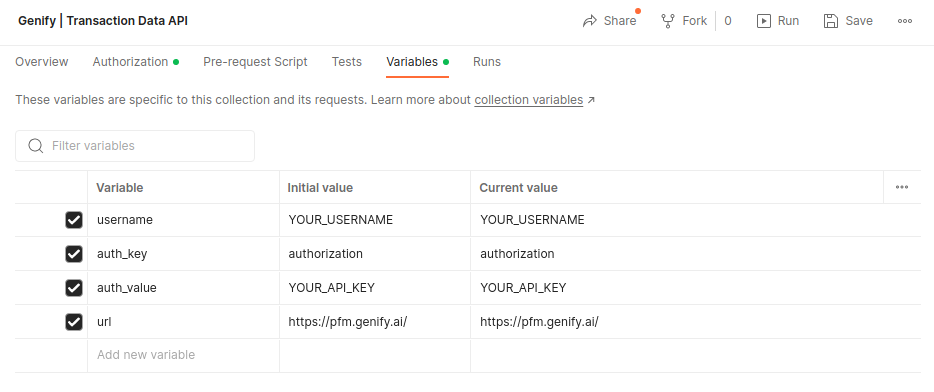
-
The Authorization tab in the collection should be configured as
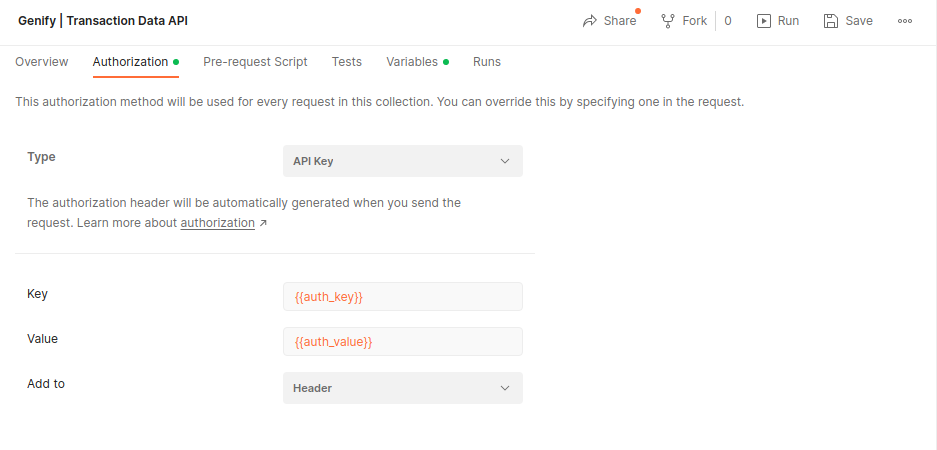
Request Headers and Parameters
Headers
- Some or all enrichment fields have been activated for your credentials ➡️ make sure to (de)activate them (1️⃣ or 0️⃣) accordingly when making API calls to avoid errors
- There are 4 enrichment fields to be activated:
categorylogocarbonfootprintwebsite
- There are also 3 essential headers that should be filled out:
username: to be filled by the variable that has been set-up previouslyaccount-id:- Can be filled by 0 during your testing
- In production, you should send an end-user pseudo-ID (1 person using your app ⇒ 1 unique pseudo-ID)
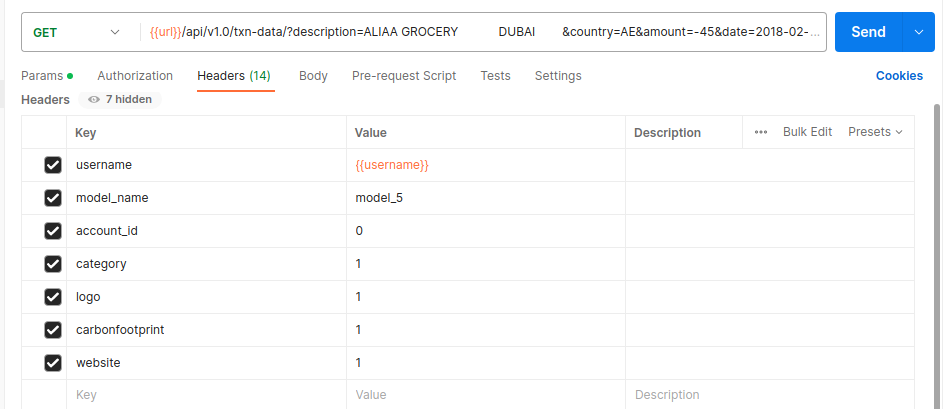
Parameters
There are 4 mandatory parameters that should be filled when making requests:
-
The description of the merchant in the
descriptionfield -
The right country in the
countryfield- E.g.:
aefor United Arab Emirates,befor Belgium,safor KSA - Full list of ISO country codes: link
- E.g.:
-
The amount spent by transaction in the
amountfield- Negative ➖ for expenses
-
The date of the transaction in the date field
- The date format is YYYY-MM-DD
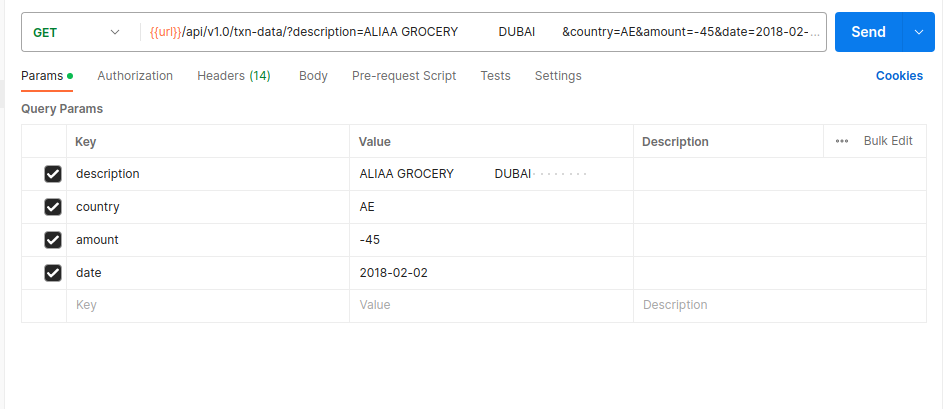
Considerations
-
There's a limited number of API calls made available to you during your initial testing
-
Negative ➖ amounts are expenses, positive ➕ amounts are incoming (i.e., income) transactions
Transaction type Example amount Expense -10.86 Incoming 21.34 -
For superior performance, it generally helps to remove from transaction descriptions any tokens not carrying information (often used for bank-internal purposes)
-
See examples below:
Raw transaction description Processed transaction descriptions KINOKUNIYA DUBAI ARE KINOKUNIYA DUBAI TAXI DUBAI ARE DUBAI TAXI NATIONAL TAXI DUBAI ARE NATIONAL TAXI CAREEM NETWORKS FZ LLC DUBAI ARE CAREEM NETWORKS FZ LLC -
A lot of such tokens are already learnt by Genify’s engine (and considered noise) but we keep encountering new ones every now and then—so, flagging 🚩 still
-
Response
Sample Response
{
"Transaction UUID": "7e993040-ad52-4646-98af-64d53b1835e2",
"Merchant ID": "00005af3107a87ca",
"Carbon Footprint": 26.316,
"Category ID": "1002",
"Category Name": "Restaurant",
"Subcategory Name": "American restaurant",
"Clean Description": "KFC Jumeirah Lake Towers",
"Country": "UNITED ARAB EMIRATES",
"Logo": "https://pfm.genify.ai/api/v1.0/txn-data/logo/KFC.png",
"Merchant Website": "https://www.kfc.com",
"Display Description": "Kfc"
}
As seen in the JSON object. There are 5 enrichment fields.
Category NameLogoMerchant WebsiteCarbon Footprint- Description is separated in 2 outputs:
Clean DescriptionDisplay Description
Category Levels
Categorization hierarchy: Genify's Transaction Data API offers 3️⃣ category levels
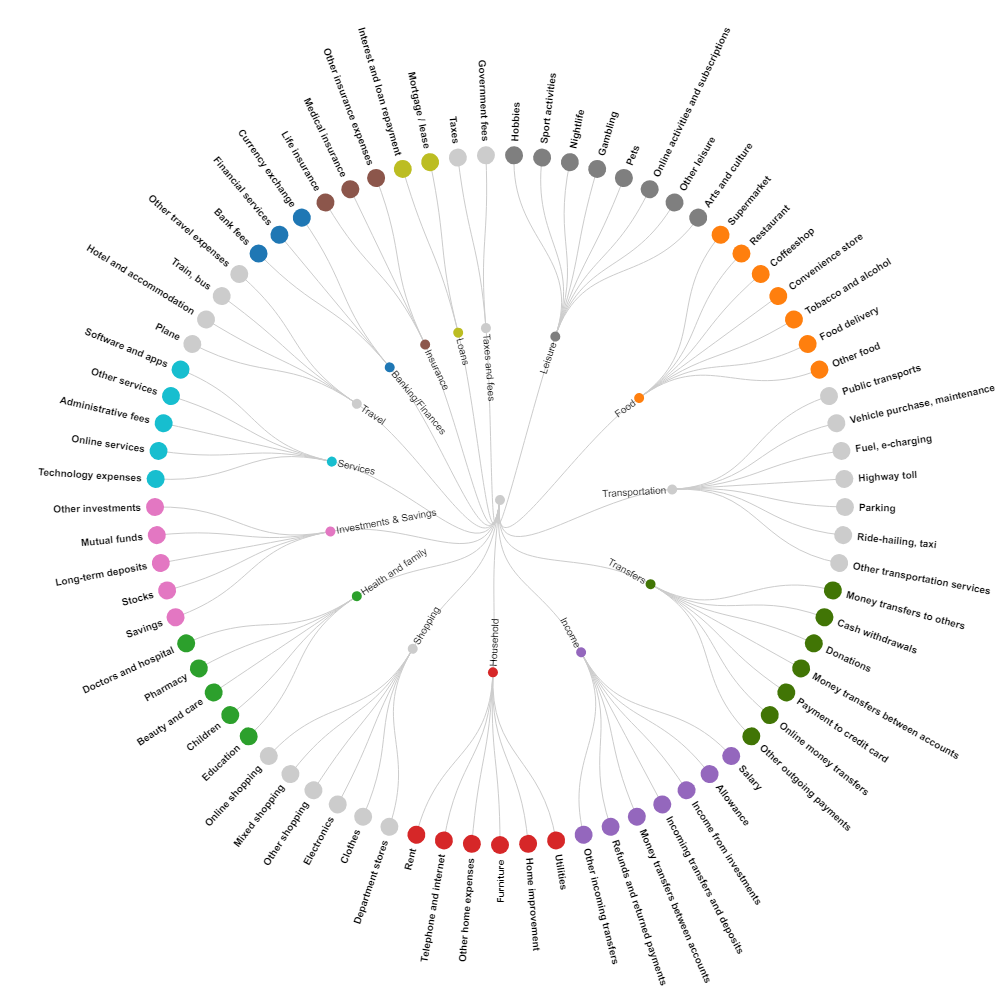
Genify's Category Tree
- Parent Category
- Each category maps to a single parent category in Genify's standard hierarchy, so the API does not return the parent category. Knowing the category implies the parent.
- Category
- Displayed in the API under
Category Name. Unknown expenses useCategory ID= 0 and unknown income usesCategory ID= 10007.
- Displayed in the API under
- Subcategory
- It is a very granular and gradually expanding free-text-like field shown in the API as
Subcategory Name. Some subcategories may initially appear unmapped, and their name will also appear in theCategory Namefield withCategory ID= 0. - These unmapped subcategories are gradually mapped to their appropriate Genify's categories over time.
- It is a very granular and gradually expanding free-text-like field shown in the API as
- Full list of categories: link (Subcategories not included as they are free text).
